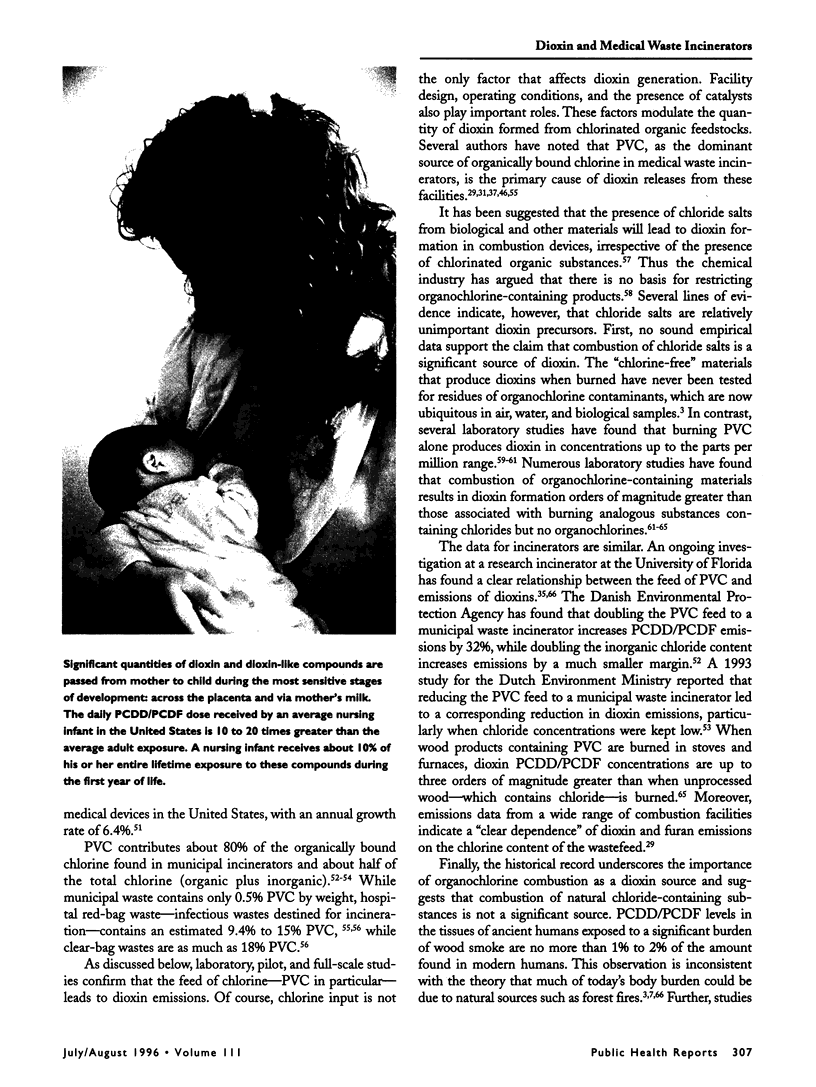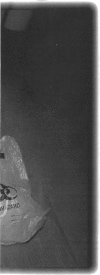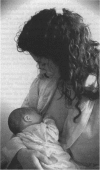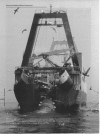Abstract
CHLORINATED DIOXINS and related compounds are extremely potent toxic substances, producing effects in humans and animals at extremely low doses. Because these compounds are persistent in the environment and accumulate in the food chain, they are now distributed globally, and every member of the human population is exposed to them, primarily through the food supply and mothers' milk. An emerging body of information suggests that dioxin contamination has reached a level that may pose a large-scale, long-term public health risk. Of particular concern are dioxin's effects on reproduction, development, immune system function, and carcinogenesis. Medical waste incineration is a major source of dioxins. Polyvinyl chloride (PVC) plastic, as the dominant source of organically bound chlorine in the medical waste stream, is the primary cause of "iatrogenic" dioxin produced by the incineration of medical wastes. Health professionals have a responsibility to work to reduce dioxin exposure from medical sources. Health care institutions should implement policies to reduce the use of PVC plastics, thus achieving major reductions in medically related dioxin formation.
Full text
PDF















Images in this article
Selected References
These references are in PubMed. This may not be the complete list of references from this article.
- Auger J., Kunstmann J. M., Czyglik F., Jouannet P. Decline in semen quality among fertile men in Paris during the past 20 years. N Engl J Med. 1995 Feb 2;332(5):281–285. doi: 10.1056/NEJM199502023320501. [DOI] [PubMed] [Google Scholar]
- Belkin N. L. Medical waste: reducing its generation. Todays OR Nurse. 1993 Sep-Oct;15(5):40–42. [PubMed] [Google Scholar]
- Bertazzi A., Pesatori A. C., Consonni D., Tironi A., Landi M. T., Zocchetti C. Cancer incidence in a population accidentally exposed to 2,3,7,8-tetrachlorodibenzo-para-dioxin. Epidemiology. 1993 Sep;4(5):398–406. doi: 10.1097/00001648-199309000-00004. [DOI] [PubMed] [Google Scholar]
- Birnbaum L. S. The mechanism of dioxin toxicity: relationship to risk assessment. Environ Health Perspect. 1994 Nov;102 (Suppl 9):157–167. doi: 10.1289/ehp.94102s9157. [DOI] [PMC free article] [PubMed] [Google Scholar]
- Bumb R. R., Crummett W. B., Cutie S. S., Gledhill J. R., Hummel R. H., Kagel R. O., Lamparski L. L., Luoma E. V., Miller D. L., Nestrick T. J. Trace chemistries of fire: a source of chlorinated dioxins. Science. 1980 Oct;210(4468):385–390. doi: 10.1126/science.6159682. [DOI] [PubMed] [Google Scholar]
- Carlsen E., Giwercman A., Keiding N., Skakkebaek N. E. Evidence for decreasing quality of semen during past 50 years. BMJ. 1992 Sep 12;305(6854):609–613. doi: 10.1136/bmj.305.6854.609. [DOI] [PMC free article] [PubMed] [Google Scholar]
- Cassel C., Jameton A. Medical responsibility and thermonuclear war. Ann Intern Med. 1982 Sep;97(3):426–432. doi: 10.7326/0003-4819-97-3-426. [DOI] [PubMed] [Google Scholar]
- Chen Y. C., Guo Y. L., Hsu C. C., Rogan W. J. Cognitive development of Yu-Cheng ("oil disease") children prenatally exposed to heat-degraded PCBs. JAMA. 1992 Dec 9;268(22):3213–3218. [PubMed] [Google Scholar]
- Davis D. L., Hoel D., Fox J., Lopez A. International trends in cancer mortality in France, West Germany, Italy, Japan, England and Wales, and the USA. Lancet. 1990 Aug 25;336(8713):474–481. doi: 10.1016/0140-6736(90)92020-i. [DOI] [PubMed] [Google Scholar]
- DeVito M. J., Birnbaum L. S., Farland W. H., Gasiewicz T. A. Comparisons of estimated human body burdens of dioxinlike chemicals and TCDD body burdens in experimentally exposed animals. Environ Health Perspect. 1995 Sep;103(9):820–831. doi: 10.1289/ehp.95103820. [DOI] [PMC free article] [PubMed] [Google Scholar]
- Dewailly E., Ryan J. J., Laliberté C., Bruneau S., Weber J. P., Gingras S., Carrier G. Exposure of remote maritime populations to coplanar PCBs. Environ Health Perspect. 1994 Jan;102 (Suppl 1):205–209. doi: 10.1289/ehp.94102s1205. [DOI] [PMC free article] [PubMed] [Google Scholar]
- Egeland G. M., Sweeney M. H., Fingerhut M. A., Wille K. K., Schnorr T. M., Halperin W. E. Total serum testosterone and gonadotropins in workers exposed to dioxin. Am J Epidemiol. 1994 Feb 1;139(3):272–281. doi: 10.1093/oxfordjournals.aje.a116994. [DOI] [PubMed] [Google Scholar]
- Enan E., Liu P. C., Matsumura F. 2,3,7,8-Tetrachlorodibenzo-p-dioxin causes reduction of glucose transporting activities in the plasma membranes of adipose tissue and pancreas from the guinea pig. J Biol Chem. 1992 Oct 5;267(28):19785–19791. [PubMed] [Google Scholar]
- Fingerhut M. A., Halperin W. E., Marlow D. A., Piacitelli L. A., Honchar P. A., Sweeney M. H., Greife A. L., Dill P. A., Steenland K., Suruda A. J. Cancer mortality in workers exposed to 2,3,7,8-tetrachlorodibenzo-p-dioxin. N Engl J Med. 1991 Jan 24;324(4):212–218. doi: 10.1056/NEJM199101243240402. [DOI] [PubMed] [Google Scholar]
- French H. M. Blueprint for reducing, reusing, recycling. AORN J. 1994 Jul;60(1):94–98. doi: 10.1016/s0001-2092(07)69677-x. [DOI] [PubMed] [Google Scholar]
- Gladen B. C., Rogan W. J., Hardy P., Thullen J., Tingelstad J., Tully M. Development after exposure to polychlorinated biphenyls and dichlorodiphenyl dichloroethene transplacentally and through human milk. J Pediatr. 1988 Dec;113(6):991–995. doi: 10.1016/s0022-3476(88)80569-9. [DOI] [PubMed] [Google Scholar]
- Glasser H., Chang D. P., Hickman D. C. An analysis of biomedical waste incineration. J Air Waste Manage Assoc. 1991 Sep;41(9):1180–1188. doi: 10.1080/10473289.1991.10466913. [DOI] [PubMed] [Google Scholar]
- Hoel D. G., Davis D. L., Miller A. B., Sondik E. J., Swerdlow A. J. Trends in cancer mortality in 15 industrialized countries, 1969-1986. J Natl Cancer Inst. 1992 Mar 4;84(5):313–320. doi: 10.1093/jnci/84.5.313. [DOI] [PubMed] [Google Scholar]
- Hoel D. G., Davis D. L., Miller A. B., Sondik E. J., Swerdlow A. J. Trends in cancer mortality in 15 industrialized countries, 1969-1986. J Natl Cancer Inst. 1992 Mar 4;84(5):313–320. doi: 10.1093/jnci/84.5.313. [DOI] [PubMed] [Google Scholar]
- Jacobson J. L., Jacobson S. W., Humphrey H. E. Effects of exposure to PCBs and related compounds on growth and activity in children. Neurotoxicol Teratol. 1990 Jul-Aug;12(4):319–326. doi: 10.1016/0892-0362(90)90050-m. [DOI] [PubMed] [Google Scholar]
- Jacobson J. L., Jacobson S. W., Humphrey H. E. Effects of in utero exposure to polychlorinated biphenyls and related contaminants on cognitive functioning in young children. J Pediatr. 1990 Jan;116(1):38–45. doi: 10.1016/s0022-3476(05)81642-7. [DOI] [PubMed] [Google Scholar]
- Koppe J. G., Pluim H. J., Olie K., van Wijnen J. Breast milk, dioxins and the possible effects on the health of newborn infants. Sci Total Environ. 1991 Jul 1;106(1-2):33–41. doi: 10.1016/0048-9697(91)90018-a. [DOI] [PubMed] [Google Scholar]
- Manz A., Berger J., Dwyer J. H., Flesch-Janys D., Nagel S., Waltsgott H. Cancer mortality among workers in chemical plant contaminated with dioxin. Lancet. 1991 Oct 19;338(8773):959–964. doi: 10.1016/0140-6736(91)91835-i. [DOI] [PubMed] [Google Scholar]
- Marrack D. Hospital red bag waste. An assessment and management recommendations. JAPCA. 1988 Oct;38(10):1309–1311. doi: 10.1080/08940630.1988.10467024. [DOI] [PubMed] [Google Scholar]
- Neubert R., Golor G., Stahlmann R., Helge H., Neubert D. Polyhalogenated dibenzo-p-dioxins and dibenzofurans and the immune system. 4. Effects of multiple-dose treatment with 2,3,7,8-tetrachlorodibenzo-p-dioxin (TCDD) on peripheral lymphocyte subpopulations of a non-human primate (Callithrix jacchus). Arch Toxicol. 1992;66(4):250–259. doi: 10.1007/BF02307170. [DOI] [PubMed] [Google Scholar]
- Paustenbach D. J., Wenning R. J., Lau V., Harrington N. W., Rennix D. K., Parsons A. H. Recent developments on the hazards posed by 2,3,7,8-tetrachlorodibenzo-p-dioxin in soil: implications for setting risk-based cleanup levels at residential and industrial sites. J Toxicol Environ Health. 1992 Jun;36(2):103–149. doi: 10.1080/15287399209531628. [DOI] [PubMed] [Google Scholar]
- Pirkle J. L., Wolfe W. H., Patterson D. G., Needham L. L., Michalek J. E., Miner J. C., Peterson M. R., Phillips D. L. Estimates of the half-life of 2,3,7,8-tetrachlorodibenzo-p-dioxin in Vietnam Veterans of Operation Ranch Hand. J Toxicol Environ Health. 1989;27(2):165–171. doi: 10.1080/15287398909531288. [DOI] [PubMed] [Google Scholar]
- Pluim H. J., de Vijlder J. J., Olie K., Kok J. H., Vulsma T., van Tijn D. A., van der Slikke J. W., Koppe J. G. Effects of pre- and postnatal exposure to chlorinated dioxins and furans on human neonatal thyroid hormone concentrations. Environ Health Perspect. 1993 Nov;101(6):504–508. doi: 10.1289/ehp.93101504. [DOI] [PMC free article] [PubMed] [Google Scholar]
- Portier C., Tritscher A., Kohn M., Sewall C., Clark G., Edler L., Hoel D., Lucier G. Ligand/receptor binding for 2,3,7,8-TCDD: implications for risk assessment. Fundam Appl Toxicol. 1993 Jan;20(1):48–56. doi: 10.1006/faat.1993.1006. [DOI] [PubMed] [Google Scholar]
- Rier S. E., Martin D. C., Bowman R. E., Dmowski W. P., Becker J. L. Endometriosis in rhesus monkeys (Macaca mulatta) following chronic exposure to 2,3,7,8-tetrachlorodibenzo-p-dioxin. Fundam Appl Toxicol. 1993 Nov;21(4):433–441. doi: 10.1006/faat.1993.1119. [DOI] [PubMed] [Google Scholar]
- Ross P. S., De Swart R. L., Reijnders P. J., Van Loveren H., Vos J. G., Osterhaus A. D. Contaminant-related suppression of delayed-type hypersensitivity and antibody responses in harbor seals fed herring from the Baltic Sea. Environ Health Perspect. 1995 Feb;103(2):162–167. doi: 10.1289/ehp.95103162. [DOI] [PMC free article] [PubMed] [Google Scholar]
- Sharpe R. M., Skakkebaek N. E. Are oestrogens involved in falling sperm counts and disorders of the male reproductive tract? Lancet. 1993 May 29;341(8857):1392–1395. doi: 10.1016/0140-6736(93)90953-e. [DOI] [PubMed] [Google Scholar]
- Tieszen M. E., Gruenberg J. C. A quantitative, qualitative, and critical assessment of surgical waste. Surgeons venture through the trash can. JAMA. 1992 May 27;267(20):2765–2768. [PubMed] [Google Scholar]
- Visalli J. R. A comparison of dioxin, furan and combustion gas data from test programs at three MSW incinerators. JAPCA. 1987 Dec;37(12):1451–1463. doi: 10.1080/08940630.1987.10466343. [DOI] [PubMed] [Google Scholar]
- Yang Y. G., Lebrec H., Burleson G. R. Effect of 2,3,7,8-tetrachlorodibenzo-p-dioxin (TCDD) on pulmonary influenza virus titer and natural killer (NK) activity in rats. Fundam Appl Toxicol. 1994 Jul;23(1):125–131. doi: 10.1006/faat.1994.1088. [DOI] [PubMed] [Google Scholar]
- Yao Y., Hoffer A., Chang C. Y., Puga A. Dioxin activates HIV-1 gene expression by an oxidative stress pathway requiring a functional cytochrome P450 CYP1A1 enzyme. Environ Health Perspect. 1995 Apr;103(4):366–371. doi: 10.1289/ehp.95103366. [DOI] [PMC free article] [PubMed] [Google Scholar]
- Zober A., Messerer P., Huber P. Thirty-four-year mortality follow-up of BASF employees exposed to 2,3,7,8-TCDD after the 1953 accident. Int Arch Occup Environ Health. 1990;62(2):139–157. doi: 10.1007/BF00383591. [DOI] [PubMed] [Google Scholar]
- Zober A., Ott M. G., Messerer P. Morbidity follow up study of BASF employees exposed to 2,3,7, 8-tetrachlorodibenzo-p-dioxin (TCDD) after a 1953 chemical reactor incident. Occup Environ Med. 1994 Jul;51(7):479–486. doi: 10.1136/oem.51.7.479. [DOI] [PMC free article] [PubMed] [Google Scholar]









